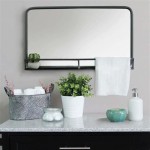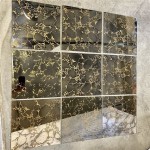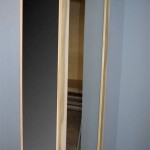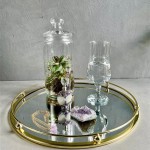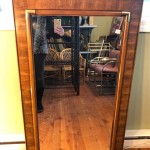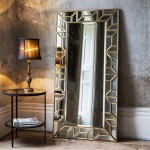How To Hang A Mirror Above A Fireplace
Hanging a mirror above a fireplace is a popular interior design choice, often creating a focal point and enhancing the aesthetic appeal of a room. A mirror can reflect light, making the space feel brighter and more expansive. However, this project requires careful planning and execution to ensure the mirror is securely mounted and does not pose a safety hazard. This article provides a comprehensive guide on how to hang a mirror above a fireplace, covering necessary preparations, essential tools, and step-by-step instructions.
Assessing the Fireplace and Surroundings
Before beginning the installation process, it is crucial to thoroughly assess the fireplace and its surrounding area. This assessment involves identifying the type of fireplace (e.g., gas, electric, wood-burning), the material of the mantel or wall above the fireplace (e.g., brick, drywall, stone), and the presence of any existing structural elements that might impact the installation. Understanding these factors is essential for selecting the appropriate mounting hardware and techniques.
The type of fireplace influences the heat exposure that the mirror will experience. Wood-burning fireplaces generate the most heat, while electric fireplaces produce the least. Excessive heat can damage the mirror's backing and cause the adhesive to fail over time. Therefore, it might be prudent to avoid hanging very expensive mirrors that would be difficult to replace over a very frequently and intensively used wood-burning fireplace.
The material of the wall or mantel is also a critical consideration. Brick and stone walls require specialized drilling techniques and anchors compared to drywall. Drywall, while easier to work with, may require additional support, such as locating studs, to ensure the mirror's weight is adequately supported. The presence and dimensions of a mantel will determine the placement height and whether the mirror will be mounted directly to the wall or to the mantel itself.
Consider the space available for the mirror. Measure the width of the fireplace and the distance from the mantel (if there is one) to the ceiling. A general rule of thumb is to choose a mirror that is slightly smaller than the width of the fireplace. This helps to create a balanced and visually appealing composition. Typically, the mirror should be no more than two-thirds the length of the mantel below.
Finally, gauge the weight of the mirror. Lighter mirrors can be hung with simpler hardware, while heavier mirrors require more robust anchors and potentially professional assistance. Knowing the mirror's weight is crucial for selecting the appropriate mounting hardware and ensuring a secure installation.
Gathering Necessary Tools and Materials
Having the right tools and materials on hand will streamline the installation process and contribute to a professional-looking result. The following is a comprehensive list of essential items:
*Mirror:
Select a mirror that complements the style and dimensions of the fireplace and the surrounding room. *Measuring Tape:
Use a measuring tape to accurately determine the placement of the mirror and the location of mounting points. *Level:
A level is essential for ensuring the mirror is hung straight and prevents a tilted appearance. *Pencil:
Use a pencil to mark the desired location of the mirror and the positions of the mounting holes. *Drill:
A drill is necessary for creating pilot holes for the mounting hardware. Choose a drill bit that is appropriate for the wall material (e.g., masonry bit for brick or stone). *Screwdriver:
A screwdriver is required for tightening the screws that secure the mirror to the wall or mantel. Alternatively, a drill with a screwdriver bit can be used. *Wall Anchors:
Select wall anchors that are suitable for the wall material and can support the weight of the mirror. Options include drywall anchors, masonry anchors, and toggle bolts. *Screws:
Choose screws that are compatible with the wall anchors and long enough to penetrate the wall securely. *Stud Finder (Optional):
A stud finder can be used to locate wall studs behind drywall, providing a more secure mounting point. *Safety Glasses:
Wear safety glasses to protect your eyes from dust and debris while drilling. *Dust Mask:
A dust mask can help prevent the inhalation of dust particles during drilling. *Painter's Tape:
Painter's tape can be used to mark the desired location of the mirror and protect the wall from scratches. *Drop Cloth:
Place a drop cloth beneath the work area to protect the floor from dust and debris.Consider purchasing a mirror hanging kit, as they often include a selection of anchors, screws, and brackets designed for hanging various sizes and weights of mirrors. These kits can simplify the hardware selection process.
Step-by-Step Installation Guide
Follow these steps to safely and effectively hang a mirror above a fireplace:
Step 1: Prepare the Area.
Begin by clearing the area in front of the fireplace and placing a drop cloth on the floor to protect it from dust and debris. If necessary, cover the mantel with painter's tape to prevent scratches.Step 2: Measure and Mark.
Use a measuring tape to determine the desired location of the mirror above the fireplace. Consider the space between the top of the mantel and the bottom of the mirror, as well as the overall height of the mirror in relation to the ceiling. Use a pencil to mark the top and bottom corners of the desired mirror placement on the wall. Use a level to ensure the marked lines are straight and horizontal.Step 3: Locate Studs (If Applicable).
If the wall is drywall, use a stud finder to locate wall studs behind the drywall. Studs provide a more secure mounting point than drywall alone. Mark the location of the studs with a pencil.Step 4: Mark Mounting Points.
Depending on the type of mirror and the mounting hardware used, mark the locations of the mounting holes on the wall. Most mirrors have D-rings or wire on the back that are used for hanging. Measure the distance between these mounting points and transfer these measurements to the wall, ensuring the marks are level and centered.Step 5: Drill Pilot Holes.
Using a drill and a drill bit that is appropriate for the wall material, drill pilot holes at the marked locations. For drywall, use a drill bit that is slightly smaller than the diameter of the wall anchors. For brick or stone, use a masonry bit and drill slowly and carefully to avoid cracking the material.Step 6: Install Wall Anchors.
Insert the wall anchors into the pilot holes. For drywall anchors, follow the manufacturer's instructions for installation. Some drywall anchors are self-drilling, while others require pre-drilled holes. For masonry anchors, insert the anchors into the holes and tap them gently with a hammer until they are flush with the wall surface.Step 7: Attach Mounting Hardware.
Attach the mounting hardware (e.g., screws, brackets) to the wall anchors. Ensure the hardware is securely fastened and can support the weight of the mirror. If using screws, tighten them until they are snug but not overtightened.Step 8: Hang the Mirror.
Carefully lift the mirror and align the D-rings or wire on the back with the mounting hardware on the wall. Gently lower the mirror onto the hardware, ensuring it is securely supported. If necessary, adjust the position of the mirror until it is centered and level.Step 9: Final Check.
Use a level to ensure the mirror is perfectly straight. Make any necessary adjustments to the mounting hardware to achieve a level and balanced appearance. Once the mirror is securely hung and level, remove the painter's tape and clean up any dust or debris.Installing above a mantel might be easier, as the mantel may provide a solid base for attaching mounting hardware. However, the same principles regarding weight and material are still applicable.
Consider using picture-hanging wire or chain to hang the mirror if you prefer a more decorative look. Be sure to use wire or chain that is strong enough to support the weight of the mirror.
For very heavy mirrors, consider hiring a professional installer. A professional installer will have the necessary experience and tools to safely and securely hang the mirror, ensuring it is properly supported and does not pose a safety hazard.

Things To Know Before Hanging A Mirror Above The Fireplace

5 Top Tips For Hanging Mirrors Above Fireplaces Living Fires
:max_bytes(150000):strip_icc()/271342800_619280975946855_5866172257895318662_n-f6b2756c1768481b9b258f56fe44d13a.jpg?strip=all)
Design Guide To Putting A Mirror Over The Fireplace

35 Mirror Above Fireplace Ideas For A Beautiful Look Nikki S Plate

Mirror Over The Mantel What Size To Get Laurel Home

5 Top Tips For Hanging Mirrors Above Fireplaces Living Fires

Convex And Round Mirrors Over A Fireplace Top Tips Omelo Decorative

Mirror Over The Mantel What Size To Get Laurel Home

35 Mirror Above Fireplace Ideas For A Beautiful Look Nikki S Plate

How To Hang Mirrors Angela Bunt Creative

